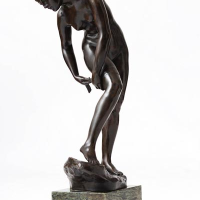Diana Wounded was produced in three different versions between 1905 and 1908, the first in statuette form (the present work), a plaster cast was also made in 1907 for the life-size marble work of the subject which was exhibited at the Royal Academy in 1908 and was later purchased by the Chantrey Bequest for the Tate Gallery collection. The bronze statuette, exhibited in 1906 at Londons Royal Academy captivated popular taste2: here, the mythological virgin huntress has none of the drama of Titians (1506-1576) famous Diana and Actaeon (1556-59) the work in which Actaeon seals his fate by intruding upon the goddess as she bathes, the outraged Diana later transforming him into a stag to be devoured by his own hounds.
Mackennals Diana Wounded reflects the artists preoccupation with the female form and the influence of New Sculpture, described here in 1901: the present general belief apparently is that in picturesqueness, restrained and in good taste, lies the future of sculpture.3 Described by Londons The Times as one of the most beautiful nudes that any sculptor of the British school has produced4 Here, Diana represented a modern beauty, the female form unadorned and without the decorative embellishments of earlier artistic styles. Mackennal commented how he saw a model doing up her stocking and quickly modelled the pose 5 his finished work is a thoroughly modern woman, conforming to British tastes of the time in composition and size.
There was a growing market for the statuettes which Mackennal produced and with the success of these, in particular Circe (1900) and Queen Victoria in Her Coronation Robes (1897), the artist had Gruet and Hohwiller foundries create duplicates of Diana Wounded. The sculpture was available in duplicate at Mackennals Macquarie Galleries exhibition in Sydney in 1926 and at the 1928 Fine Art Society exhibition, Melbourne. After the success of this show, the artist wrote to W. H. Gill in relation to his 1928 exhibition at this venue; I am not surprised that Diana went well. She usually does. I have sent to Hohwiller, my bronze founder in Paris, where some of my bronzes are made, to send you two Dianas. They will be out in Melbourne about three weeks after this letter.6
The popular appeal of Bertram Mackennals subject, Diana, owes to the sensuous line, elegant balance and intricate detailing, qualities which characterise the artists best works. The statuette of Diana Wounded can be found in major national and international collections including The Ashmolean Museum, Oxford; the Art Gallery of South Australia, Adelaide and the National Gallery of Victoria, Melbourne.
Footnotes
1. Capon, E., cited in Edwards, D., Mackennal, Art Gallery of New South Wales, Sydney, 2007, p.7
2. Hutchison, N., cited in Edwards, D., Mackennal, Art Gallery of New South Wales, Sydney, 2007, p.116
3. Spielmann, M.H. (ed.), British Sculpture and Sculptors of Today, Cassell, London, 1901
4. The Royal Academy: second notice, 8 May 1908, Times, London, p.6, cited in cited in Edwards, D., Mackennal, Art Gallery of New South Wales, Sydney, 2007, p.67
5. Jacobs, I., Art Abroad, A Review Art and Architecture, Sydney, vol.9, no.1, Jan-Feb 1912, p.418, cited in Edwards, D., Mackennal, Art Gallery of New South Wales, Sydney, 2007, p.116
6. W.H. Gill papers, Mitchell Library (MS285/14), cited in Works, CD-ROM accompanying the text Mackennal, Art Gallery of New South Wales, Sydney, 2007
Caroline Jones BA, MArtAdmin
